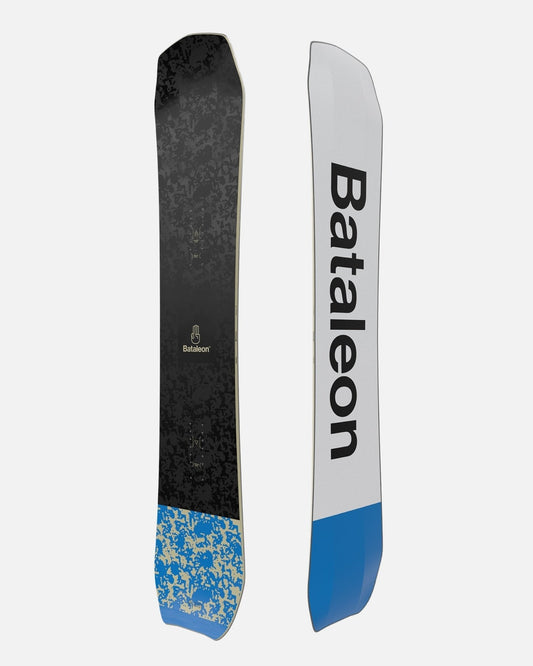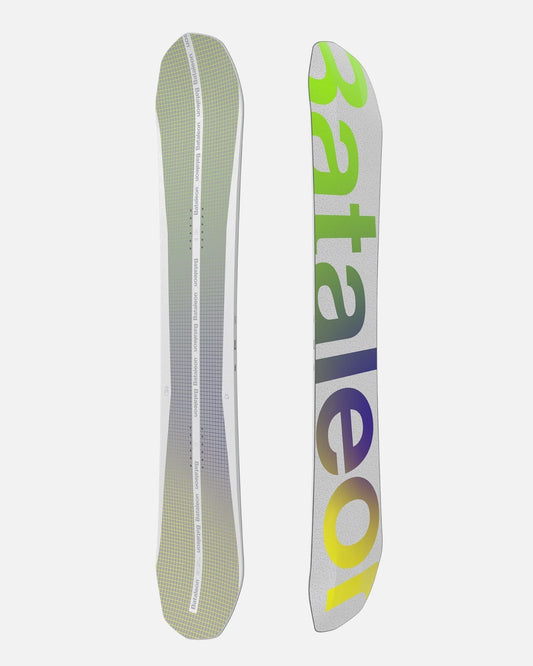The truth is, there’s nothing that comes close to the feeling of snowboarding through powder. And to truly get the most out of the experience, you want to be riding a board that’s designed for deep snow.
What is a powder snowboard?
Picture your dream day. It probably starts by opening the curtains to see a couple of feet of fresh snow has fallen overnight. You neck a coffee, grab your shit and hustle to make the first lift with your friends (at least, the ones who can keep up). The rest of the day is a quick-cut highlights reel of deep turns and trees, face-shots and cliff drops, pillow lines and grins...
The truth is, there’s nothing that comes close to the feeling of snowboarding through powder. And to truly get the most out of the experience, you want to be riding a board that’s designed for deep snow.
Powder snowboards are nothing new. Back in the early days of snowboarding, guys like Dimitrije Milovich took inspiration from surfing to create snow craft with pointed noses, rockered profiles and swallow tails. But as freestyle snowboarding took off in the late 80s and 90s, people switched their directional boards for more symmetrical outlines that make it easier to turn and land switch. Even as the market grew for more versatile all-mountain snowboards, most of the silhouettes looked pretty much the same.
More recently, there has been a resurgence in interest for boards that focus on the simple joy of laying down turns, whether on or off the piste. This has resulted in an explosion of new shapes.
Some people call these shapes ‘crazy’ – and to be honest, a lot of the weirder boards on the market don’t work that well. At Bataleon, we focus first and foremost on performance – not how it looks. How does a board feel to ride? Does it float, carve or spin like it’s supposed to? When it comes to our more creative shapes, form is a product of function; there is always a reason for their geometry that’s grounded in science.
While the quiver concept (the idea of owning more than one board for different conditions) has gained a lot of traction over the past few years, the best thing about Bataleon’s ‘powder snowboards’ is that with Triple Base Technology, they can hold their own anywhere on the mountain. If you live for powder but will take whatever conditions the gods throw at you, look no further than 3BT.
How are powder snowboards designed?
-
Shape
The key to a powder snowboard is float. The nose needs to rise easily to the surface of the snow, and the tail needs to sink to enable you to turn with minimal effort. The optimum shape is therefore a long, wide nose with loads of surface area, tapering into a short and narrow tail. In other words: directional. Check out the Cruiser and Party Wave for a classic example. Stubby boards like these are super nimble – ideal for threading lines down chutes and through trees.
Swallowtails like the one on the Surfer work by reducing the surface area in the middle of the tail – encouraging it to sink – whilst maintaining a long effective edge. This enables more drawn out turns in the pow and soulful carves on the piste.
Learn more about snowboard shapes here.
-
Length & Width
Back in the 90s and 00s, freestyle snowboards were short and freeride snowboards were long. These days, things have moved on. The length of a board which kills it in the powder can be as short as 144 cm ThunderStorm or even 138 cm (as in the smallest example of the Surfer Mini)
The key to performance in deep snow is really surface area – which can be achieved by increasing the width rather than length, and by fine-tuning its overall shape (see above). This is known as ‘volume shift’ – a term borrowed from surfing, where flotation is also the name of the game.
If you’ve got big feet, the good news is that when it comes to powder snowboards you’ll be spoilt for choice!
For a more in-depth look at how width affects a snowboard, check out our article on Understanding Snowboard Width.
-
Flex
There’s no rule that says powder snowboards need to be stiff or soft. Some of the world’s top freeriders will favour a firm deck that offers snappy turns and maximum stability when flying down an Alaskan face at 90 miles per hour. Others prefer the playful characteristics of a softer model.
When selecting a powder board, ask yourself what kind of a rider you are. Are you going to be launching off big cliffs or tackling icy sections on the entry to your favourite couloir? And are you heavy? Then a stiffer flex will suit you.
To be honest, most people’s idea of a fun powder day is a little more mellow: hacking through trees, popping airs off little mushrooms and trying the occasional nose butter. This is why most of our powder-focused directional snowboards – like the Party Wave and Surfer – are designed with a softer flex.
All that said, many powder boards feature a flex pattern that’s fine-tuned in different zones, including a stiffer tail and a softer nose. This improves drive through turns and helps the front of the board to stay afloat.
At Bataleon, we use a bunch of technology to tailor the flex on every model. You can read about this in our article on Understanding Snowboard Flex.
-
Profile & 3BT
A lot of manufacturers deploy reverse camber (aka rocker) in their powder snowboards. The idea is that by curving the profile upwards towards the nose and tail – like a ‘U’ shape – the board will naturally want to float.
We believe there’s a better solution. While rocker boards do work (kinda) in deep snow, they suck on hardpack – and unless you’re getting dropped by a heli at the top of your descent, chances are you’re going to need to negotiate some groomers on any given powder day. What’s more, full rocker boards turn less efficiently than traditional camber, even in freshies.
Triple Base Technology (3BT) approaches the idea of profile in 3D. From the nose to the tail, all Bataleon’s snowboards feature a version of classic camber – meaning they offer excellent ollie power, engaged edges and an all round lively feel. On our powder snowboards, this camber is lowered a little to help keep the tips afloat. But instead of being flat across the base from one edge to the other, 3BT introduces uplifted sides in specific zones.
This three-dimensional shape has numerous advantages (for a full explanation check out Camber vs Rocker vs Triple Base Technology) but when it comes to riding powder, it means you get way more float – and smoother turns – without the shitty downsides of rocker.
You only have to look at the nose of one of our powder-focused snowboards like the Cruiser to see it just makes sense. In the same way the hull of a boat is designed to carve through the waves, 3BT optimizes a snowboard for its natural environment.
Over nearly two decades we’ve fine-tuned Triple Base Technology into five different flavours. Our ‘Pow 3BT’ features a narrow centrebase and maximum uplift with SideKick (an even steeper bevel) in the nose. It offers unrivalled float in soft snow and will plough through any cookies and crud while holding its own on the hard stuff.
You’ll find Pow 3BT on the Surfer, the Surfer Mini, the Party Wave, Cruiser and the ThunderStorm.
Powder snowboards
Conclusion – What is the Best Powder Snowboard?
If you’re looking to squeeze the maximum fun from a powder day, you should swap your standard shape snowboard for something a little more exciting.
Tapered outlines, swallow or crescent tails and extra width all have their advantages. The key is to focus on surface area and float rather than an old school measure like length.
The right powder board for you will depend on how much you’re likely to use it elsewhere on the mountain (is this your only board, or one for the quiver?) and whether you prefer aggressive performance (suggesting a stiffer flex), nimble turns (go short) or drawn out carves (go long).
Lastly, don’t get hung up on reverse camber and hybrid profiles. A classic camber will still perform better in deep snow when paired with Triple Base Technology.
Frequently asked questions about powder snowboards
FAQ
Which powder board can also handle cruising the resort and trees?
In general, all of Bataleon’s powder-oriented snowboards handle resort and tree riding very well. We’d recommend looking at models like the Party Wave or Cruiser – both are great options that feel comfortable riding quickly through trees and in open powder fields.
I already have a snowboard for all-mountain and playful riding and I’m looking to get a powder-specific board. Which model should I purchase?
If you’re looking for a powder-specific, the Surfer or Party Wave would be an excellent choice and will compliment your quiver.
I’m looking for a powder board that handles carving really well. Which model should I go for?
Easy. All of our directional snowboards handle cruising the slopes well, but if you’re mostly cruising the slopes with fresh powder on the side, the Thunderstorm and Cameleon models are the ones we’d recommend looking at first.
How does Triple Base Technology help me with riding powder?
Triple Base Technology helps riders float in deeper snow due to the base contour. The 3BT hull-like shape generates increased uplift – which can be compared to a ship’s hull – helping deflect any crud, and staying on top of the snow.
Buyers Guide
View all-

-

Bataleon's Best Freestyle Snowboards
Up your game in the park, on the street or in the backcountry. Check out our freestyle snowboards.
Bataleon's Best Freestyle Snowboards
Up your game in the park, on the street or in the backcountry. Check out our freestyle snowboards.
-





